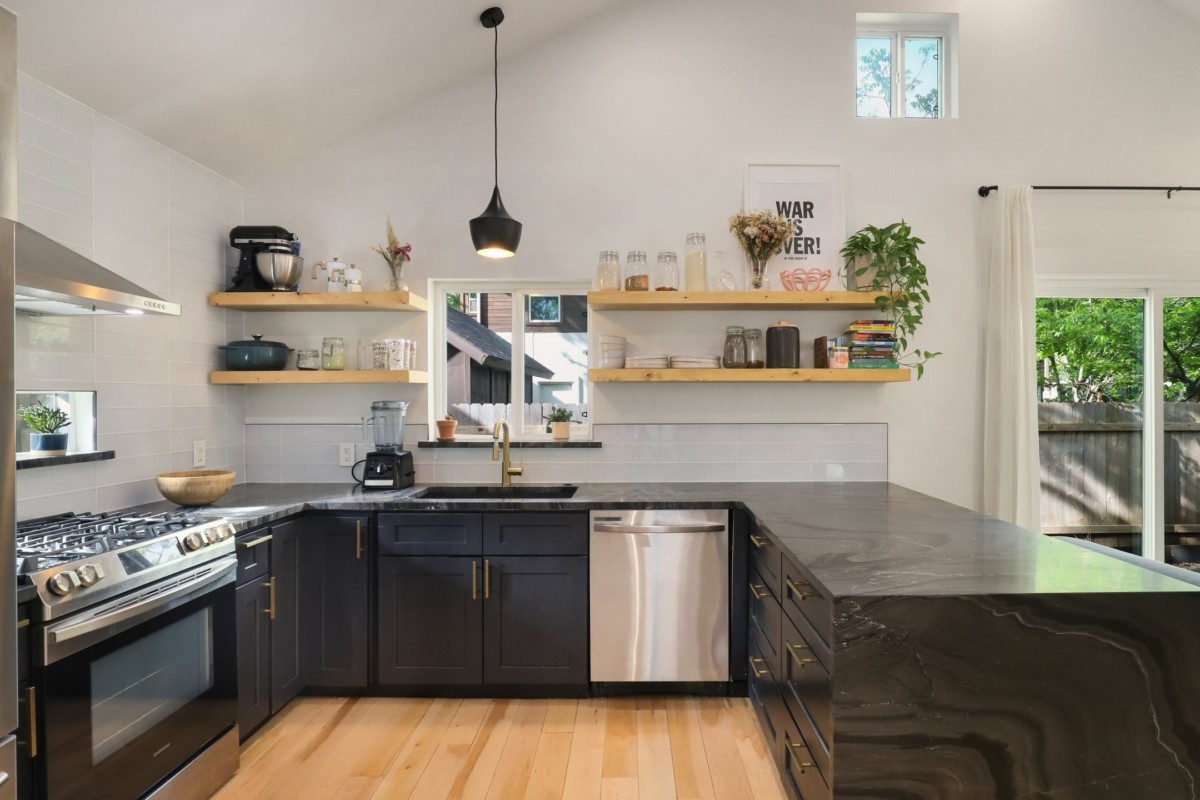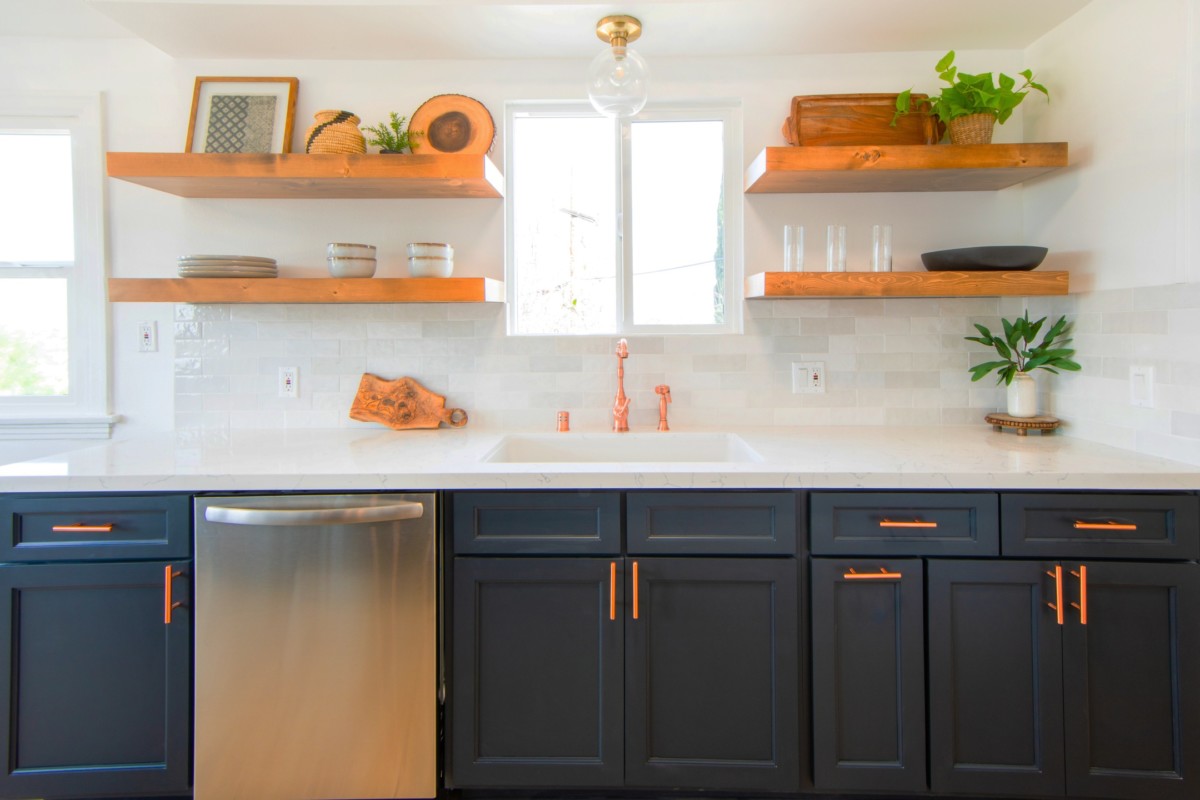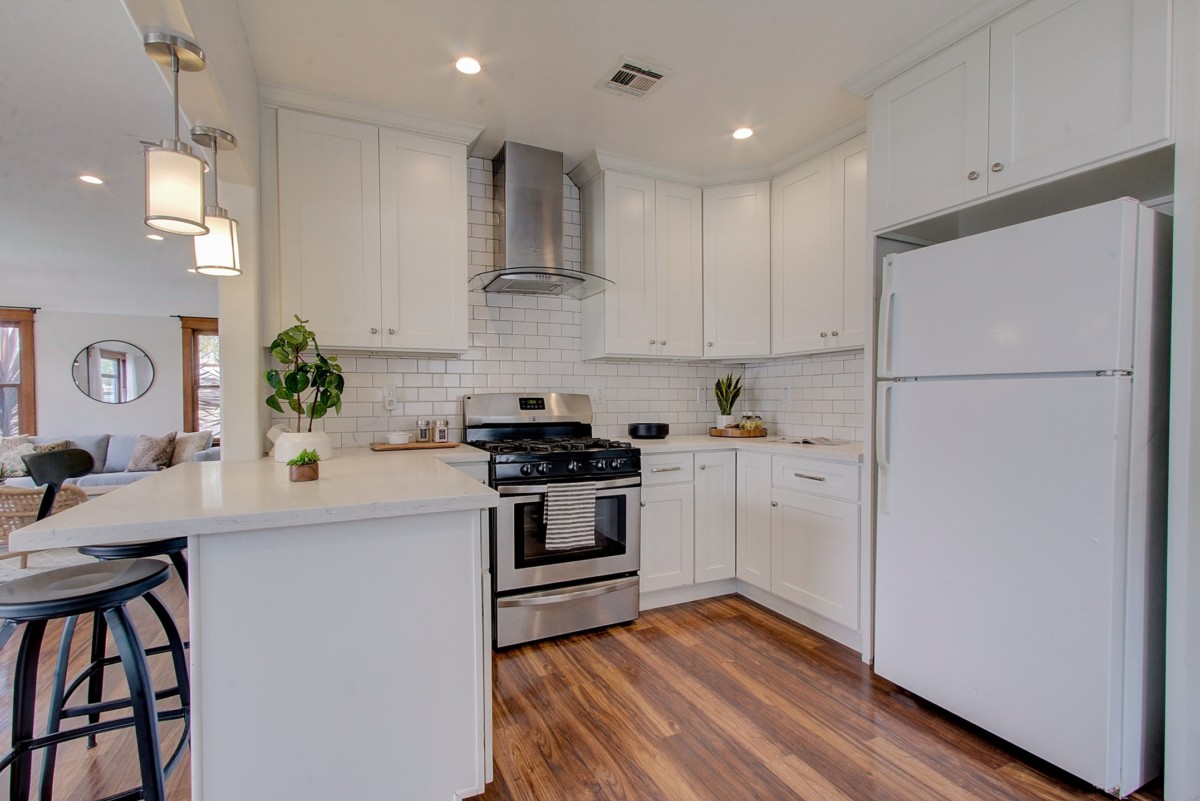Living in an apartment often means tighter living spaces, smaller bedrooms, and a smaller apartment kitchen. Keeping your space tidy can help make your apartment feel less cramped and look bigger. But when you have lots of cooking gadgets and small space, where do you start? And how can you keep the place organized over time?
We’ve reached out to professional organizers from Columbus, OH, to Charlotte, NC, and everywhere in between, for their best apartment kitchen organization tips and tricks. Find out what they had to say so you can start organizing your apartment’s kitchen – and keep it clean.

Use all your vertical space
When it comes to maximizing a small kitchen, it’s important to utilize vertical space in cabinets, pantries, and closet doors. Shelf risers, under-shelf storage baskets, and over-the-door systems are a few of my go-to products when organizing a kitchen with limited storage space. Additionally, to prevent clutter, I encourage clients to keep one to two of a specific item accessible and put any others in “backstock,” a separate area within your home or garage that can be used to store additional inventory. – Charlotte Berlin, Simplified by Charlotte, Chicago, IL
Take care of the “clutter culprits”
To make a small kitchen work for your family, focus on decluttering the “clutter culprits” that take up way too much space. Items such as coffee mugs and water bottles, Tupperware, appliances, and serving dishes tend to hog the prime real estate of your kitchen, and often have a lot of redundancy. If you can reduce by 10-25% in these areas, you’ll recover some precious storage space to make your kitchen much more comfortable and spacious. – Jen Van Buskirk, The Neat Boutique, Mount Pleasant, SC
Maximize your space
The trick to organizing small kitchens is to maximize usable space. In your cabinets, this might mean adding under-shelf baskets, stacking shelves, or vertical dividers. But don’t forget the side of your fridge (where you can put your spice rack or aluminum foil), underneath your cabinets (where you can hang mugs), and above your doorway (where you can add a shelf to put recipe books). If you see any dead space, be creative and think about how you could make the most of it. – Laura Gutowski, Everything in its Space, Charleston, SC
Don’t keep half-empty boxes of food
When you have a box of granola bars with just one left, that empty box is taking up valuable space, creating clutter, and not contributing to an overall organizational system. Boxes also don’t always stack neatly. By decanting granola bars and other single-serve snacks into bins, people can find what they’re looking for and you’re prioritizing pantry space for the things that matter. – Jen Munafo, The Everyday Organizer, Cincinnati, OH
Gadgets should serve multiple purposes
I frequently share these two tips to make a big impact on organizing a small kitchen. First, eliminate gadgets that have a single use, such as an avocado slicer or the bulky apple corer. These items take up precious real estate while a simple, sharp knife serves a variety of functions. Second, add stick-on hooks inside cabinet doors to hang utensils or measuring cups and spoons. – Kimberly Wolfe, Abundant Life Organizing, Orlando, FL
Start by sorting items together
Even a small kitchen contains many different types of items, which can seem overwhelming. Begin organizing your kitchen by sorting like items together into smaller subcategories. This allows for multiple benefits: keeping things manageable so the project continues to move forward, easily seeing the quantity of each subcategory you have to declutter effectively, and clearly showing the amount of space you need when finding a place for everything within your pantry, cabinets, and drawers. – Suzanne Reiss, Dawnlight Organizing, New Jersey
Focus on three simple steps
When organizing an apartment kitchen, I encourage my clients to focus on the following three steps:
- Declutter items you don’t need, use, or love (broken appliances, unused wedding gifts, mismatched cups)
- Organize the remaining items (silverware near the dishwasher, cooking utensils near the oven, drink glasses near the fridge)
- Measure, order and install organizing supplies. This gives everything a home, holds everyone accountable and maintains order in the home.
– Logan G. Alderman, Orderly SC, Charleston, SC

Choose what you use, not what you think you need
Don’t feel compelled to keep full sets when it comes to dishes, knives, or pots and pans. If you like the salad bowls and plates from your dishes set, but never use the cups and saucers, then donate them. If you have four different sizes of saucepans but always pick the same one or two to cook with, then find a great charity that can benefit from your castoffs. – Jamie Gibberman and Kristin Gorin, Get Organized RVA, Richmond, VA
Go for quality over quantity
To cultivate minimalism in your small kitchen, choose quality over quantity every time, and learn essential basic cooking skills. As an example, owning one high-quality chef’s knife and knowing how to use it well will serve you better than having a variety of knives and guessing at which one to use each time you need to make a cut. Also, choose tools that can do multiple jobs such as glass food storage containers that can also be used for serving or a blender that is also a food processor. – Ginger Willis, Element of Fun Organizing, Washington, DC
Measure shelves before you buy your supplies
It’s important to make sure your supplies fit your space just right, so measure your shelves before you buy. Your small kitchen should flow, with plates and spices by the stove and glasses near the fridge. Labeling your storage containers will help create a routine so that everything goes back in the same place every time. Utilize every part of your space, vertically and horizontally. – Adrienne Krantz, Life Arranged, LLC, Columbus, OH
Storage bins will help you organize your shelves
When working with smaller spaces, there are a couple of simple tricks that really make a difference. Storage bins are transformative, so make sure the fit fills your shelves. Once your system is in place, throw away all of those Costco-sized cardboard boxes and place individually wrapped items straight into your new bins. This winning combination is both visually appealing and easy to keep organized moving forward. – Kayla Fichtner, Spatial Solutions, Alabama
Believe it or not, you’ll have an easier time keeping a small apartment kitchen organized
What I love about a small kitchen – it’s easy to keep clean and organized. The more you have, the more you have to clean. Everything in a smaller kitchen should have a purpose. Make sure that a beautiful bowl can be displayed and used as a serving piece. Multi-purpose pieces are critical. Be sure to watch out for duplicates. If you go to the same strainer or pan every time, get rid of the others that serve the same function. Add open shelving to give light and airy storage. Lastly, there’s zero room for clutter – collect the mail somewhere else. This will make your space appear larger and more peaceful. – Carol Coffey, Coffey Home Organization, Charlotte, NC
Make sure what you have is what you need
Optimizing space is key when working with a small kitchen, so first, we recommend purging everything that’s expired – from strawberries to spices, condiments to crackers. Then make sure you’re making the most of valuable real estate by putting everyday ware front and center in the cabinets, with special occasion dinnerware and/or serving less accessible. Finally, focus on putting like things together, not only so you know what you have and don’t overbuy, but also where to easily find what you’re looking for. – Jessica Bailey, Room Reset, Charlotte, NC
And get rid of things you don’t use or that are broken
When organizing a small kitchen, it’s important to purge unnecessary items. Remove things such as kitchen gadgets that are never used, excessive utensils, plates, cups, and anything worn or broken. Always store like items together and close to where they will be used in the space. Lastly, the cabinet above the fridge or microwave is a great place to store items you rarely use. – Lynn Moulthrop, Simply Organized, Culpeper, VA

Make use of any corner cabinets
If you have children, find a space to store their cups, plates, and bowls in an area that they can reach. Some good spots to consider are a lazy Susan corner cabinet or a low drawer. This fosters independence and saves you some sanity. If they want a snack, they can reach their dishes without your help. – Julia Goldberg, Love It and Label It, Indianapolis, IN
Declutter, map it out, and label
For anyone trying to create more organization in their kitchen/pantry, I recommend the following three tips:
- Declutter – Pull everything out and to see how much you have of each item and what you actually use. Decide what you want to keep, throw away, or donate. *Note: start slow with this step so you don’t overwhelm yourself.
- Map it out – Strategically identifying zones is very valuable. If items are in places that make sense and are easy to put away, it will be more likely to stay organized.
- Label – Label every zone: shelves, drawers, bins, baskets, etc. This will help keep things in order for all household types.
– Erica Kuehl, The Kuehl Touch, St. Louis, MO
Don’t overthink the decluttering process
Our tips for apartment kitchen organization are similar to our general organizing tips. You’ll want to pull everything out and declutter, declutter, declutter. Do this before buying/making any storage containers. Once you’ve decluttered, place like categories together into bins, don’t over-think this. The tell-tale sign that you need to declutter, is when your bins are overflowing – don’t put more into the space than can fit. These are easy ways to clue you in, faster, and never get overwhelmed by clutter again. – Easy Organizing Solutions, Southern and Central, Michigan, Northern and Central, Indiana
Enjoy the process and set the right expectations
As a professional organizer, I always love to help my clients feel the least overwhelmed by setting the right expectation for the project. In a kitchen, my suggestions would be to always start small. For example, start with a drawer and move on to cabinets, etc later. I would also recommend going with subcategories when organizing, for example, mugs with mugs, cups with cups, etc. Also important is taking measurements for every area before buying any storage products. Finally, don’t try to do it all at once, and make sure you’re enjoying the process. And remember, always declutter first and organize later. – Lastree Lemene, Ready Set Declutter, LLC, Orange County, FL
Keeping a small kitchen tidy is not hard
Here are a few easy tips. Always place items back in the place it belongs so it doesn’t leave your kitchen feeling cluttered. Put as much as you can into closed spaces. Use stackable organizing shelves/racks. Use over-the-door pantry organizers for storage. – Bees Housekeeping, Charlotte, NC
Apartment kitchen organization can require creativity
No pantry? Perhaps you can use an over-the-door system if a door is closed. Maybe there’s a closet nearby that can hold a small rolling cart for appliances you may not often use like a mixer or bread maker. Your cabinet doors can be used to hang items like mixing cups and spoons or lids to your pots and pans. Hidden spaces can be your solution to an organized tiny space. – Pamela Bowers, Chaos Pros, Frisco, TX
Be methodical about what you keep and where you store it
Pull out all kitchen equipment. Go drawer by drawer, cabinet by cabinet. Decide what items are non-negotiable. The things you couldn’t imagine functioning in your kitchen without. Keep those items separated from all the other things.
Then go through what didn’t make the cut. Are some of these items necessary to keep (special serving platters, a roasting pan for holiday meals, a large stockpot) but hardly used? Since we’re working with limited space in the kitchen, is there another location they could be stored?
Try to be ruthless with the remaining items that didn’t make it into the first two categories. Consider if you still need the item at this stage of your life, if the item is a duplicate, how much wear and tear the item has endured, and if the item is a single-function gadget (looking at you, pickle tongs). – Brittany, Zenia Organizers, Summerville, SC

 United States
United States Canada
Canada